
It wasn’t until I found myself with a restless newborn who needed endless hours being pushed in a pram that I overcame my fear of commercial art galleries.
Intimidated by the white walls, clean lines and hushed silence, I hadn’t previously understood the rules of engagement and certainly didn’t think I could afford to purchase the art that lined their elegant walls. Why enter a retail gallery if I couldn’t buy?
Turns out there are countless reasons. Art gallerists know it is a rare occurrence for somebody to walk in off the street and leave with a freshly purchased artwork. Theirs is the craft of the long sell, a lifetime’s education and a vast network of connections.
If you know nothing, art gallerists can tell you everything; if you know a little, they tend to be energised by the opportunity to go deeper. It goes both ways. When the renowned Australian surrealist sculptor Patricia Piccinini was starting out, she worked the door on a Melbourne art co-op, an experience she says gave her an invaluable education in how people interact with art.
My breakthrough came while pushing my firstborn through Surry Hills, where, behind the big glass windows of Ray Hughes Gallery, a series of brightly painted chooks forged from corrugated iron caught my eye. Above them hung paintings of country show prize-winning handicrafts and cakes.
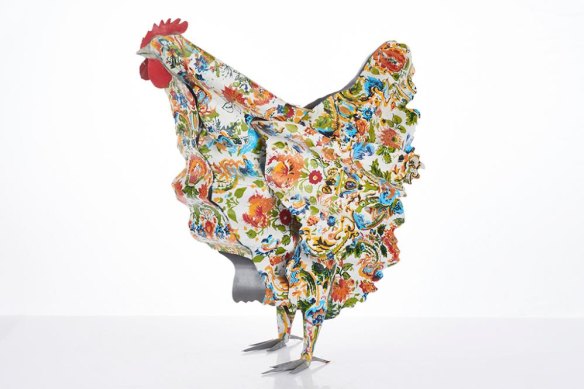
Jeff Thomson’s Rooster, 2005 caught the writer’s eye.
I wasn’t pressed for time; the baby was finally settled, and the exhibition’s promise of unpretentious fun powerfully beckoned me through the dark industrial entry. I hoicked the pram up a few stairs and into the converted warehouse showroom.
There were the mandatory white walls, but the soaring unfinished ceilings and uneven timber flooring placed the gallery in a middle ground between shabby and chic; unpredictable baby sounds were lost amid the drafts.
If I hadn’t found Hughes’ exhibition of paintings by Lucy Culliton and chooks by Jeff Thomson so joyful, I would have fled in fear when I spotted the eponymous owner at a desk just inside the entry.
Hughes was a gruff giant who I came to learn could be found each morning in that spot drinking coffee and reading the papers. It was from Hughes and later his son, Evan, that I came to understand that art galleries and their owners love tyre kickers like me.
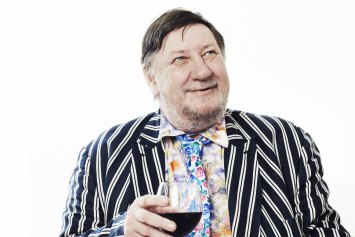
Legendary art dealer Ray Hughes.Credit: Damian Bennett
Conveniently for us, commercial galleries tend to cluster in geographical locations; among the densest is around Trumper Park, Paddington, where, at any time, it is possible to see more than half a dozen bespoke exhibitions.
Unlike Australia’s public institutions, the exhibitions are refreshed every few weeks, they’re free, and generally, they’re not crowded. Go at the right time, and you might even receive a free glass of wine. Plus, you’re bound to encounter fresh and inventive work from mostly local artists. While our government-funded galleries have often been slow to discover the charms of art by women, contemporary commercial galleries no longer have this problem.
Martin Browne Contemporary, opened in 1991, is a case in point with both of its current exhibitions by women.
Sally Ross’ big tropical blue-green pointillist landscapes in scale, tone and price ($8,000 to $19,000) each seem destined for a wall in a large modern Australian home.
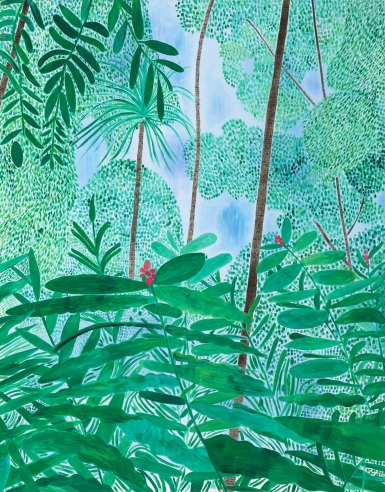
Sally Ross’ oil on board Tropical Berry Plants (2024) is on sale for $14,000.
Browne’s back gallery features a series by Linde Ivimey, one of the country’s most captivating sculptors, known for her humanlike figures rendered from fabrics, resin and other materials, including trademark tiny bird bones.
Ivimey has inhabited the upper echelons of Australian art for three decades. Her pieces are in the collections of the National Gallery of Victoria and the National Gallery of Australia (although, shockingly, she has not been acquired by her hometown’s Art Gallery of NSW), and if you do not see them now, you may never have another chance because once acquired it could be years before they are again shown publicly, if ever. Having said that, the exhibition’s sales success is indicative of the sluggish art market of the past 18 months as few items (priced $15,000 to $30,000) have found buyers.
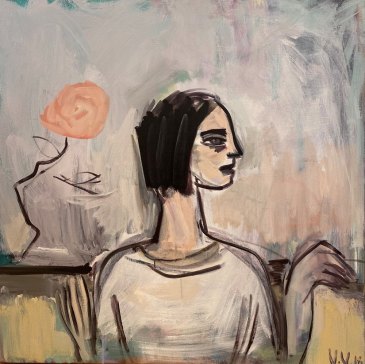
Vicki Varvaressos’ Woman with ‘Just Joey’, 2018.
A minute’s walk away, the long-established Australian Galleries is also platforming a female artist, with the veteran Sydney expressionist Vicki Varvaressos showing glazed ceramic sculptures, acrylic portraits and still lifes distinguished by heavy black lines evocative of Charles Blackman’s art.
Varvaressos has been one of our most prolific painters, exhibiting nearly every year since 1975, however at 75, this is her first exhibition of new work since 2017.
Upstairs, Angus Fisher is, as with Varvaressos, a graduate of the National Art School, albeit 37 years later, and his exhibition is a collection of large landscape sketches in charcoal and a series of small zoological studies ink pen and watercolour.
Unfortunately for me, a little toadfish, beautiful in its ugliness and priced at $1,250, is marked with a tiny red sticker indicating it has been sold. Both exhibitions close on Saturday, so best see them while you have the chance.

Angus Fisher’s Toadfish was priced at $1,250 at Australian Galleries.
Assuming approximately half that price will go back to the artist, where it will cover his materials and other costs, and the other half to the gallery, which has three people working there when I visit, it’s a modest sum flowing back into our city’s creative economy.
Back on Hampden St, Wagner Contemporary upstairs is showing a collection by Christopher Orchard, the former head of drawing at Adelaide Central School of Art.
If you like William Kentridge’s art, you will enjoy Orchard’s meditations, which are dominated by suited bald men and occasionally a Pulcinello.
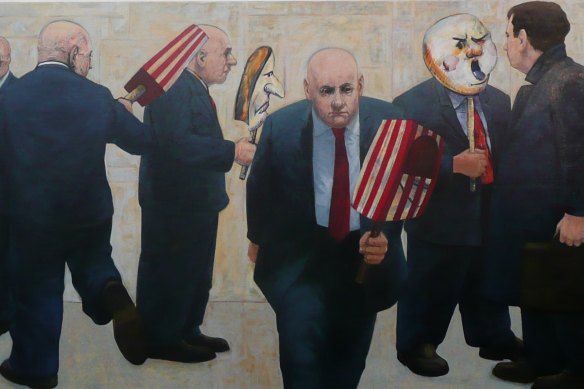
Christopher Orchard’s Proxy at Wagner Contemporary.
In addition to some large oil paintings, there are many simple charcoal renderings on paper, and seeing the collection together reveals how the artist uses drawing to express the gamut of human emotions.
Annette Larkin Fine Art also has a single-artist exhibition of new works, except her artist, Australian modernist painter Carl Plate (pronounced Plaa-ter), died in 1977.
Moving into Abstraction is Larkin’s fourth exhibition since 2017 of items from the Plate estate, which has a healthy following in Sydney’s legal circles.
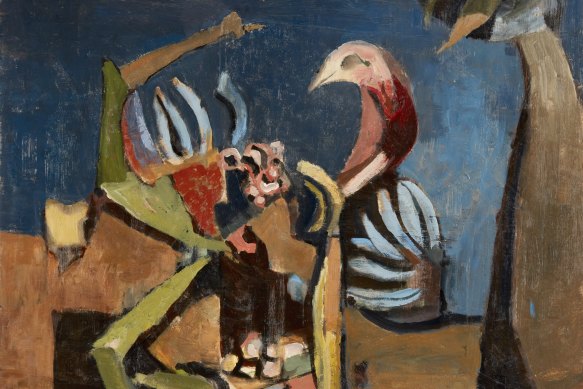
Carl Plate’s Ladys Fingers (1954) at Annette Larkin Fine Art.
Next door, Roslyn Oxley9 Gallery is exhibiting a showstopping collection of luxe Hollywood golden-era style staged photography by Sir Isaac Julien, a British filmmaker and installation artist who interrogates racism and the legacy of American slavery (and will also show at the Museum of Contemporary Art in an exhibition opening this weekend).

Isaac Julien’s Dream Deferred (Once Again... Statues Never Die), 2022,Credit: Courtesy of the artist
Oxley is one of just a few Australian galleries that can make a commercial success of exhibiting international artists but with the top price tag in this collection, £66,000 (why bother with AUD?), it remains to be seen if the works will sell in this market.
If the diversity of fresh art on display within just a few hundred metres isn’t enough, it is possible right now to step across the threshold of Justin Miller Art and see a Picasso vase with an owl figure ($95,000) sitting not far from a Warhol line sketch of a monkey ($85,000) looking at a huge Damien Hirst spin painting ($575,000).
A former head of art auction house Sotheby’s in Australia, Miller’s business model differs from his neighbouring galleries as he consigns artworks from mostly local collectors and then works his contact book to find a buyer.

Pablo Picasso’s Face and Owl, 1958.
On any given day, it’s possible to see $2 million worth of art by internationally renowned artists jostling for space in the modest-sized gallery. Marvellous as some pieces are – my favourite is a magnificent red geometric John Coburn visible from the footpath.
Loading
Returning to Hughes’ gallery, it closed in 2015, and he died two years later. Lucy Culliton’s career has continued to flourish, she now shows with King Street Gallery and her prices have steadily risen.
The chooks? A couple of them went under the hammer on Tuesday night when Ray’s son Evan Hughes sold the last of his late father’s collection through auction house Shapiro.
In mint condition, Thomson’s Rooster, 2005 fetched $1350 and Pecking Chicken, 2005 $1595, under the hammer









 Add Category
Add Category